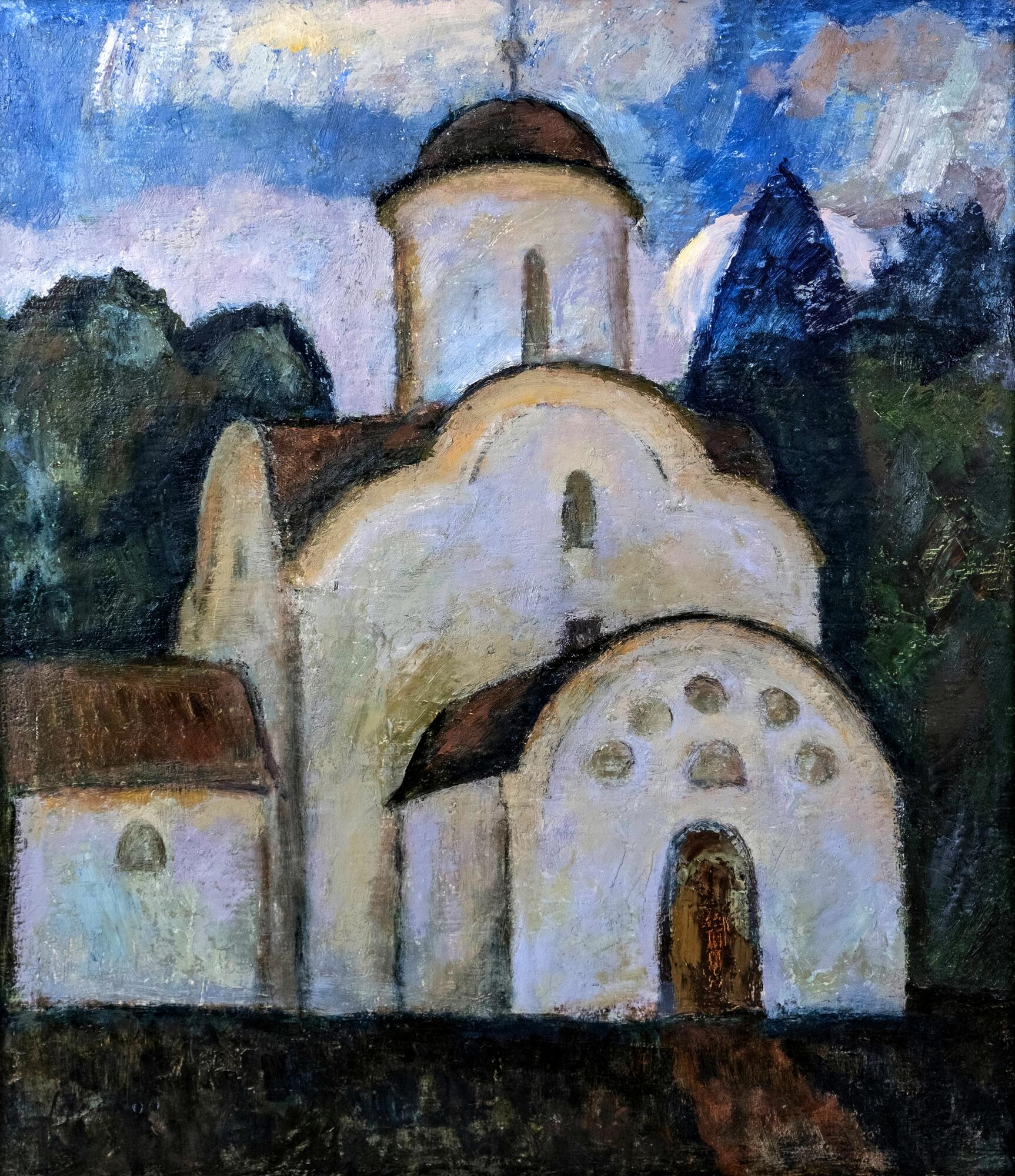The Church of the Assumption of the Theotokos in Volotovo is located on the shore of the Maly Volkhovets, not far from the road from St. Petersburg to Moscow.
The church was founded in the mid-14th century by Archbishop Moses, as evidenced by the chronicle entry: “In the same summer <1352> Archbishop Moses built the stone church in the name of the Assumption of the Holy Theotokos in Volotovo.” In the chronicle of 1363, it is mentionaed that “the church was attributed” to the Moses Monastery (as the Volotovo Monastery was once called).
The Volotovo Field district was a significant place for the Slavs even before the Christianization of Rus. Archeologists managed to find there a complex of seven pagan sopkas (burial mounds); one of the burials, according to legend, belongs to Gostomysl, an elder who advised the Novgorodians to call Rurik to reign. The toponym “Volotovo” comes from the word “volot” — “giant”, or “gigantic” which can denote the vastness of both the field itself and those who rest in the mounds.
In the 14th century, near that area, an important road ran to Moscow, to the Khutyn Monastery of St. Varlaam, and to Rurik’s Gorodische, a princely court.
In 1386, when the troops of Prince Dmitry Donskoy were approaching Novgorod, the Novgorodians burned many monasteries, including the one on Volotovo Pole, but later many of them were restored.
In 1501, under Prince Ivan Vasilyevich and his son Vasily Ivanovich, the monastery received a “privileged status”, which gave it significant benefits and made it somewhat independent from secular authorities.
During the Swedish occupation, the monastery was not destroyed, but it became so impoverished that it could not regain its former glory. In 1691, Tsar Alexis of Russia ordered the monastery to be attributed to the Yuriev Monastery.
Until 1941, the Assumption Church was in great condition, and its unique 14th-century frescoes were preserved. However, it suffered greatly for two and a half years when it was on the Volkhov front line, under heavy shelling and bombing.
In 2003, experts managed to fully restore the church, preserving the ancient sections of masonry and wall paintings. The church is the only surviving building of the monastery ensemble.
Georgy Vasilyevich Gorevoy, who was born into a peasant’s family in the Novgorod region, survived the occupation in Russia, then Latvia and Prussia. He lost his family early and was brought up in an orphanage. He attended a children’s art studio, and then graduated from a vocational school. Gorevoy worked at a factory and in a forestry station, was a sailor and a border guard. In the 1960s, he began his journey to become an artist. Now Georgy Vasilyevich is a member of the Novgorod branch of the Artists’ Union and a participant of republican and All-Union exhibitions.
The church was founded in the mid-14th century by Archbishop Moses, as evidenced by the chronicle entry: “In the same summer <1352> Archbishop Moses built the stone church in the name of the Assumption of the Holy Theotokos in Volotovo.” In the chronicle of 1363, it is mentionaed that “the church was attributed” to the Moses Monastery (as the Volotovo Monastery was once called).
The Volotovo Field district was a significant place for the Slavs even before the Christianization of Rus. Archeologists managed to find there a complex of seven pagan sopkas (burial mounds); one of the burials, according to legend, belongs to Gostomysl, an elder who advised the Novgorodians to call Rurik to reign. The toponym “Volotovo” comes from the word “volot” — “giant”, or “gigantic” which can denote the vastness of both the field itself and those who rest in the mounds.
In the 14th century, near that area, an important road ran to Moscow, to the Khutyn Monastery of St. Varlaam, and to Rurik’s Gorodische, a princely court.
In 1386, when the troops of Prince Dmitry Donskoy were approaching Novgorod, the Novgorodians burned many monasteries, including the one on Volotovo Pole, but later many of them were restored.
In 1501, under Prince Ivan Vasilyevich and his son Vasily Ivanovich, the monastery received a “privileged status”, which gave it significant benefits and made it somewhat independent from secular authorities.
During the Swedish occupation, the monastery was not destroyed, but it became so impoverished that it could not regain its former glory. In 1691, Tsar Alexis of Russia ordered the monastery to be attributed to the Yuriev Monastery.
Until 1941, the Assumption Church was in great condition, and its unique 14th-century frescoes were preserved. However, it suffered greatly for two and a half years when it was on the Volkhov front line, under heavy shelling and bombing.
In 2003, experts managed to fully restore the church, preserving the ancient sections of masonry and wall paintings. The church is the only surviving building of the monastery ensemble.
Georgy Vasilyevich Gorevoy, who was born into a peasant’s family in the Novgorod region, survived the occupation in Russia, then Latvia and Prussia. He lost his family early and was brought up in an orphanage. He attended a children’s art studio, and then graduated from a vocational school. Gorevoy worked at a factory and in a forestry station, was a sailor and a border guard. In the 1960s, he began his journey to become an artist. Now Georgy Vasilyevich is a member of the Novgorod branch of the Artists’ Union and a participant of republican and All-Union exhibitions.






